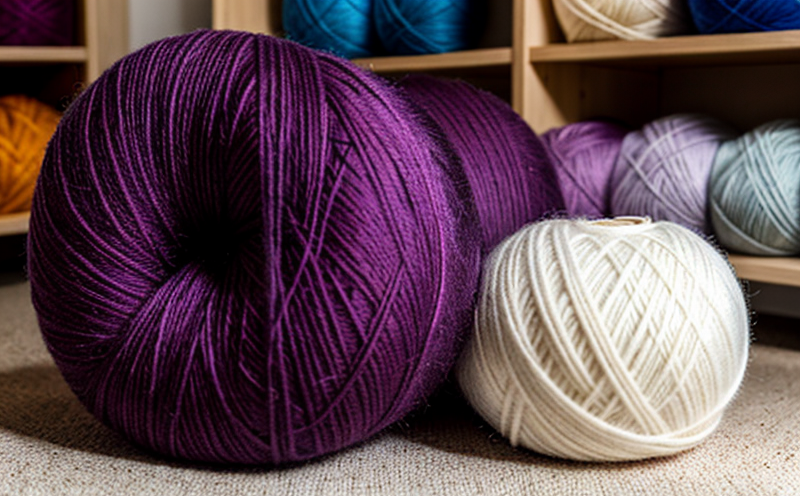JIS L1097 Testing Methods for Yarn Evenness
The JIS (Japanese Industrial Standard) L1097 specifies methods for evaluating yarn evenness, which is a critical parameter in textile manufacturing. Yarn evenness refers to the uniformity of the cross-sectional area along its length and affects fabric quality, durability, and overall performance.
Understanding yarn evenness is essential because it directly impacts the mechanical properties of textiles, such as strength and elasticity. A non-uniform yarn can lead to inconsistencies in fabric, which may result in poor product quality or failure during use. Therefore, JIS L1097 testing is crucial for ensuring that textiles meet industry standards.
The test method involves measuring the variation in cross-sectional area along the length of a yarn specimen. This measurement is typically expressed as standard deviation (σ) and coefficient of variation (CV). The higher these values, the greater the variability or unevenness in the yarn.
For accurate testing, specimens are prepared according to JIS standards. Typically, samples are cut from fabric swatches or manufactured fibers, ensuring that they meet specific dimensions and lengths as dictated by the standard. Testing instruments used include micrometers, digital calipers, and specialized software for data analysis. These tools help in obtaining precise measurements and calculating evenness indices.
The procedure involves mounting yarn samples on a tensile tester equipped with an appropriate fixture. The specimen is then stretched while its cross-sectional area is recorded at regular intervals. This continuous measurement provides detailed information about the yarn's evenness, allowing for accurate evaluation of quality.
Acceptance criteria vary depending on the intended use and end product requirements. For instance, high-end garments might have stricter limits on evenness to ensure superior comfort and appearance, whereas industrial applications may prioritize strength over uniformity slightly more.
JIS L1097 testing is widely used across various sectors including apparel manufacturing, automotive upholstery, and technical fabrics for medical textiles. It ensures that yarns produced meet quality expectations set by international standards like ISO 26845 and ASTM D3890.
| Industry | Application |
|---|---|
| Apparel Manufacturing | Evaluating yarn evenness for high-quality garments |
| Automotive Upholstery | Ensuring consistent fabric quality in seat covers and headrests |
| Tech Fabrics (Medical) | Maintaining uniformity in surgical drapes and bandages |
The importance of JIS L1097 testing cannot be overstated. By providing accurate data on yarn evenness, this method helps manufacturers maintain consistent quality across production batches. This consistency translates into better customer satisfaction and reduced waste from rejections or returns.
Moreover, adherence to such standards enhances the reputation of companies involved in textile manufacturing. It demonstrates commitment to excellence and compliance with global best practices, which is increasingly important as markets become more competitive and regulatory requirements evolve.
In conclusion, JIS L1097 testing plays a vital role in ensuring that yarns used in textiles are uniform enough to meet desired performance characteristics. Its application extends beyond just the textile industry but also influences related sectors like fashion design and product development.
Industry Applications
- Evaluating yarn evenness for high-quality garments
- Ensuring consistent fabric quality in seat covers and headrests used in automotive upholstery
- Maintaining uniformity in surgical drapes and bandages within the medical sector
The data collected through JIS L1097 testing is valuable not only for improving product quality but also for identifying potential issues early in the manufacturing process. This can prevent costly recalls later on and improve overall efficiency.
Furthermore, compliance with these standards can open up new market opportunities by meeting stringent regulatory requirements imposed by different countries around the world. As global trade continues to grow, maintaining high-quality standards becomes even more crucial for gaining access to international markets.
Quality and Reliability Assurance
The JIS L1097 testing method is essential for quality control processes in textile manufacturing. It ensures that yarns produced meet strict evenness requirements, thereby enhancing fabric quality and reliability. Here are some key points regarding how this testing contributes to quality assurance:
- It provides objective measurements of yarn evenness, enabling precise evaluation.
- The standard deviation (σ) and coefficient of variation (CV) values generated by the test offer insights into production variability, helping identify areas for improvement.
- By comparing current results against historical data or industry benchmarks, manufacturers can track trends over time and make informed decisions about process adjustments.
- Incorporating JIS L1097 testing into quality assurance protocols ensures consistent product performance across different batches of yarns.
Regular application of this method helps maintain uniformity in fabric production, leading to enhanced durability and aesthetic appeal. This consistency is particularly beneficial when dealing with large-scale productions where minor variations could significantly affect final outcomes.
Additionally, the reliability assured by JIS L1097 testing extends beyond just internal quality control measures. It also supports external audits conducted by third-party organizations responsible for certifying compliance with international standards. Such certifications contribute positively to brand reputation and customer trust.
Competitive Advantage and Market Impact
Adhering to JIS L1097 testing offers several competitive advantages in the textile industry:
- Innovation Leadership: By continuously improving yarn evenness through rigorous testing, companies can stay ahead of competitors who may not emphasize this aspect as much. This innovation drives product development and enhances market appeal.
- Better Product Quality: Consistent yarn quality ensures superior fabric performance, which translates into higher customer satisfaction and loyalty.
- Compliance with Standards: Meeting JIS L1097 requirements aligns products with international standards, making them suitable for export markets. This opens up opportunities to tap into larger global markets while avoiding potential barriers caused by non-compliance.
The competitive landscape in the textile sector is rapidly evolving due to advances in technology and changing consumer preferences. Companies that embrace JIS L1097 testing demonstrate their commitment to excellence, which can serve as a differentiator in highly competitive environments.
In summary, incorporating JIS L1097 testing into operational procedures not only enhances product quality but also strengthens market positioning by aligning with global standards and fostering innovation within the organization.





